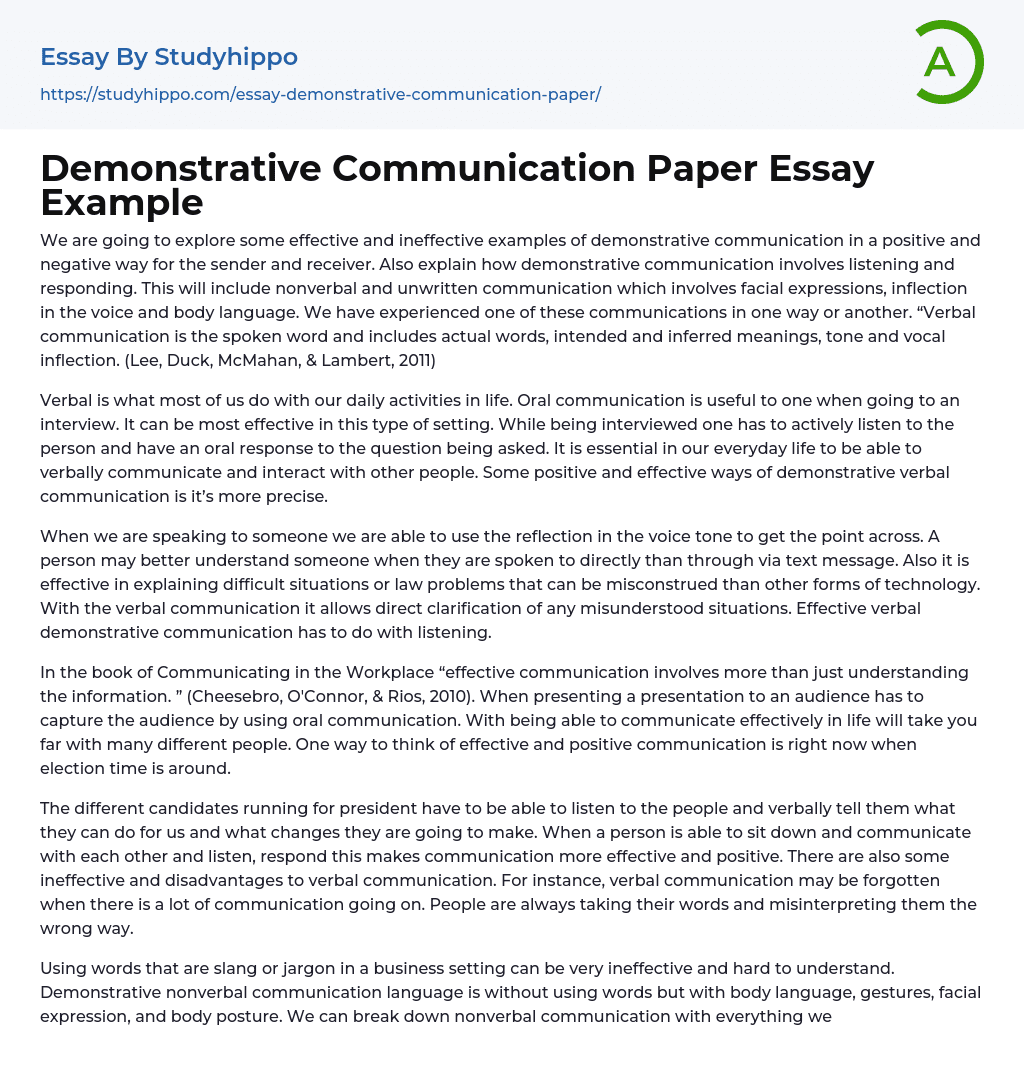We will be scrutinizing instances of demonstrative communication that have been both effective and ineffective from the perspective of both the communicator and recipient. Furthermore, we'll emphasize the crucial role active listening and feedback play in this kind of communication. Demonstrative communication involves nonverbal and non-written ways to convey messages like facial expressions, vocal tone, and body gestures. We all have experienced these methods of communication at some point. "Oral communication includes spoken language, explicit or implicit meanings, intonation, and changes in voice pitch." (Lee, Duck, McMahan ; Lambert, 2011)
Most of our everyday activities require spoken communication. Instances such as job interviews particularly emphasize the value and efficiency of verbal interactions. It's vital to listen carefully and respond correctly during an interview process. The capacity to verbally interact with others is essential in daily life. A sig
...nificant benefit of skilled verbal communication is its ability to provide superior accuracy.
The tone of voice we use when communicating directly to someone can often make our point clearer compared to text messaging. Direct verbal interaction often results in better understanding, particularly in complex scenarios or legal issues that may be misinterpreted via other technological mediums. Verbal communication provides an opportunity for immediate clarification of any confusions or misunderstandings. The effectiveness of verbal demonstrative communication greatly hinges on attentive listening.
In their book, Communicating in the Workplace, Cheesebro, O'Connor, and Rios (2010) emphasized that efficient communication is not just about understanding information. It is crucial to captivate your audience with vibrant verbal narration during speeches or presentations. Proficiency in this kind of exchange can lead to positive interactions with individuals from divers
backgrounds. This notion is particularly significant during elections when encouraging and positive dialogue is imperative.
It is imperative for those running for presidency to have the ability to comprehend societal issues and clearly convey their planned solutions and changes. Constructive discussions occur when people are provided a platform to communicate, share, and exchange thoughts. Nevertheless, verbal communication comes with its own set of obstacles. For instance, when there's an information overload, spoken messages might be missed or forgotten. Further, there's an ongoing risk that listeners may misinterpret what they hear leading to confusion.
Utilizing casual or industry-specific lingo in a business setting can lead to misunderstandings and reduced productivity. Conversely, nonverbal communication is dependent on actions of the body, facial expressions, gestures, and stance rather than verbal speech. Such methods of conveying messages play an essential role in our everyday interactions. For instance, during initial encounters with people, we usually rely on these silent cues before starting a verbal conversation. These visual assessments aid us in deciding whether we want to get to know that person better. Additionally, it's common for us to use quiet signals from within our vehicles to interact with fellow motorists.
For example, if we find ourselves stuck behind another car at a traffic light that doesn't move when the signal turns green, we use our horn to signal them it's their turn to go. Nonverbal communication has an array of positive and valuable uses. Infants depend on sounds as a form of self-expression from birth before they acquire language capabilities. Our understanding of these nonverbal signals helps us decipher what the baby is trying to communicate.
We rely on these unspoken cues for numerous daily interactions like maintaining eye contact or recognizing others without spoken interaction. Furthermore, a teacher can gauge your engagement or comprehension by observing your body language during class discussions.
It's our responsibility to assess the authenticity of an individual's emotional demonstrations as interpreters of implied signals. Nonverbal communication is crucial in our personal relationships, whether it be showing love through a hug or welcoming someone new with a handshake. However, nonverbal exchanges can sometimes be counterproductive and viewed unfavorably. We may unconsciously emit negative energy unknowingly. Therefore, caution should be exercised while using these nuanced forms of communication. For example, keeping eye contact with an unfamiliar person could potentially be misconstrued as antagonism.
In various cultural contexts, nonverbal communication through physical touch could be deemed unsuitable. Moreover, an individual may misinterpret nonverbal signals, thereby delivering an unintended message. To summarize, demonstrative and nonverbal communication are methods through which we engage and respond to one another. These techniques are beneficial for establishing better relationships in both our professional and personal lives. The utility of demonstrative communication aids in our comprehension and learning about communication principles.
- Communication Skills essays
- Cross-Cultural Communication essays
- Effective Communication essays
- Greeting essays
- Intercultural Communication essays
- Interpersonal Communication essays
- Nonverbal Communication essays
- Orality essays
- Dialect essays
- English Language essays
- Second Language essays
- Semiotics essays
- Sign Language essays
- Spanish Language essays




